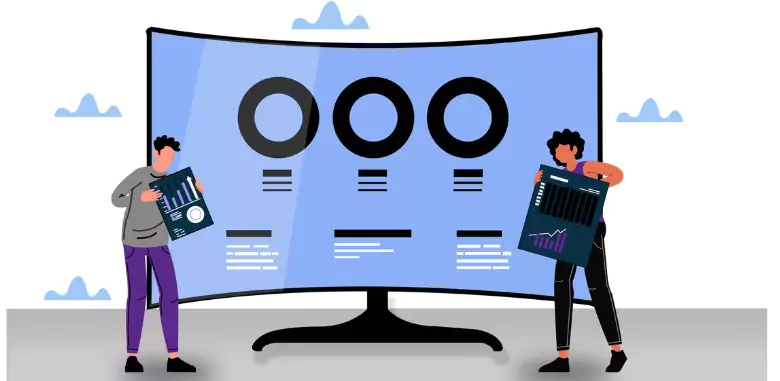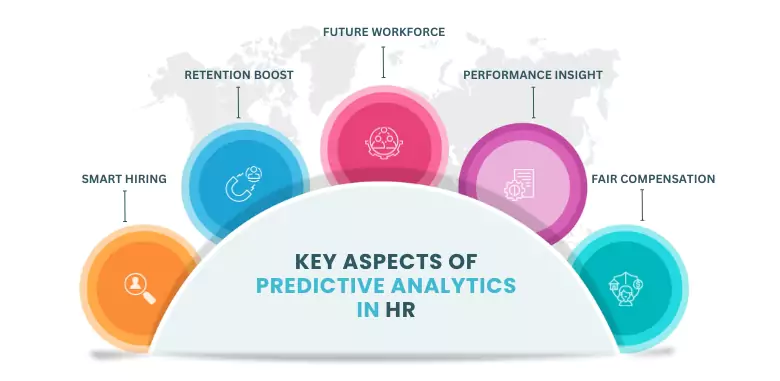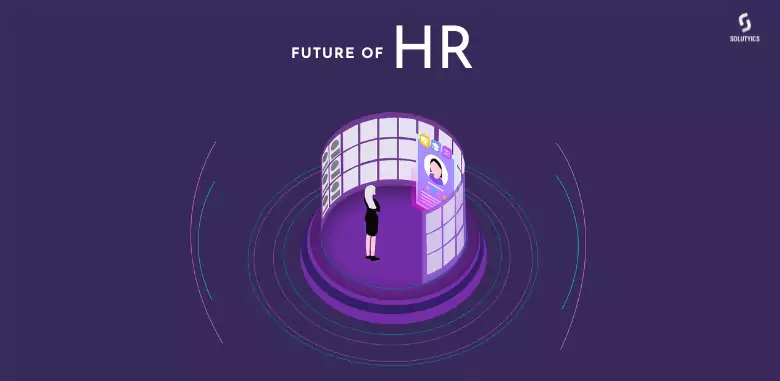
HR department deals with managing the workforce of an organization. The main functions of HR include recruiting qualified candidates for jobs, conducting their interviews, and selecting the best-fit candidate. It welcomes and integrates new candidates into the organization by providing them orientation, and training, ensuring that their employees have the resources they need to succeed. It plays a very important role in the company’s success. Predictive analytics on the other hand, is a type of analytics, involving predictions about future.
Now let’s understand how Predictive Analytics can be applied in HR:
Predictive Analytics in HR means using data and computer analytics to predict future outcomes related to human resources. It helps HR professionals make smart decisions from hiring the right candidates to making sure that they remain satisfied by. It is all about using information in the best possible way to know what is going to happen.
The following are the ways in which predictive analytics is used in HR. Read these for more clarity about the subject:
- Recruitment and Selection: The first step is always hiring candidates for your firm. Here HR department comes into play. They can analyze past data to determine which qualifications and characteristics of employees will lead to the hiring of good performers. A predictive model can also help in predicting the candidates who are more likely to stay with the company for the long term and perform well.
- Employee Retention: In the US, the average annual turnover rate is 47 percent . This turnover rate is very high and it has certain disadvantages such as reduced productivity of the firm and increased time spent in the hiring of employees, their training, and onboarding. High employee turnover can lead to a decrease in employee morale. Now the question arises why are we telling you this? And how is it related to Predictive Analytics? Can Predictive.
Analytics solve these issues faced by organizations?
The answer to these questions is “Yes!” Predictive Analytics can forecast employee turnover by analyzing past employee turnover data. By identifying those factors that will further lead to employee turnover, HR can reduce those factors and ultimately increase employee retention. Predictive analytics can also help identify the employees who are likely to leave the company in the near future. This information can help HR in taking steps to retain those employees. - Workforce Planning: HR can use predictive analytics to forecast the workforce’s future needs, e.g., by keeping an eye on retirements, resignations, and growth estimates, they can ensure the right talent is available when needed. It reduces the risk of a shortage of staff at a time of need.
- Employee Performance: Companies can track their employees’ activity. The predictive models can assess employee performance by observing historical data. In this way company can identify its high-potential employees and allocate resources for employee development and training.
- Compensation and Benefits: Companies can develop predictive models that predict changes that need to be made in the benefits packages of their employees. This can increase employee job satisfaction and retention. For example, a company observes higher turnover among employees due to their dissatisfaction with their benefit packages. The company customizes its benefits through predictive analytics. Through insights they come to know that older employees prioritize retirement benefits and healthcare coverage while younger employees value flexible work hours and career development opportunities. Then they introduce flexible work schedules and offer additional professional development opportunities for the “Young Professionals” segment and for the “Experienced Staff,” they enhance retirement benefits and healthcare coverage. Now their benefits align with their needs which as a result reduces the turnover rate and enhances employee satisfaction.
Read in depth about Marketing Predictive Analytics.
- Talent Development: “No growth without change”.HR can create personalized development plans for its employees by using predictive analytics and analyzing work history, performance, and flaws. It helps make employees more efficient and helps them achieve perfection in their tasks.
- Employee Engagement: Employee engagement has a huge contribution to an organization’s accomplishments and in order to achieve its goals a company must increase it. Predictive Analytics can check employee engagement by analyzing data of employees and tracking their activities. HR can then take action accordingly to improve engagement. This will ultimately increase the productivity of the organization.
- Time and Attendance: By predictive analytics, companies can analyze attendance data, and predict future trends in employee attendance. It is a very useful application as it will lessen the shortage of employees and maintain work fluency.
- Health and Safety: Predictive Analytics can forecast health and safety risks based on previous incident data. It allows HR to implement preventive measures to reduce risks and ensure a safer workplace.
- Succession Planning: Companies can identify potential successors for key roles within the organization. Predictive analytics helps them see into the future and figure out who can take over important jobs when employees retire. So when employees retire there could be a smooth transition in the role of employees. Predictive Analytics allows HR to align succession planning with the company’s long-term strategic goals. This allows the company to make sure that the right people are in the right place so every task is performed in a better way. These steps show exactly how predictive analytics enhances an organization’s HR management and upgrades the results. This ultimately contributes to the success of an organization.

Real-life examples of predictive analytics in HR:
- IBM’s Predictive Attrition Program: IBM used predictive analytics to address employee attrition (turnover). They developed a predictive model that analyzed various factors such as job role, location, salary, and employee survey data. By identifying employees at risk of leaving the company, IBM was able to implement targeted retention strategies, reducing turnover and retaining valuable talent.
- Xerox’s Call Center Employee Retention: Xerox utilized predictive analytics to reduce employee turnover in its call centers. They analyzed historical data and factors like employee satisfaction, performance metrics, and training programs. By identifying trends associated with high turnover, Xerox made adjustments to improve employee engagement, leading to a 20% reduction in turnover.
- PWC’s Campus Recruiting: PricewaterhouseCoopers (PwC) implemented predictive analytics to improve its campus recruiting efforts. They analyzed data from resumes, interviews, and assessment tests to predict which candidates were more likely to succeed in their roles. This helped PwC make better hiring decisions and allocate resources more effectively in the recruiting process.
- General Electric’s Flight Risk Prediction: General Electric (GE) applied predictive analytics to assess flight risk among its employees. By analyzing factors such as performance ratings, promotions, and salary increases, GE identified employees at risk of leaving the company. This allowed HR to proactively engage with these employees, offer career development opportunities, and reduce attrition rates.
- Starbucks’ Scheduling Optimization: Starbucks utilized predictive analytics to optimize employee scheduling. They analyzed historical sales data, foot traffic, and weather patterns to forecast customer demand accurately. By aligning employee schedules with predicted demand, Starbucks improved labor efficiency, reduced overtime costs, and ensured that stores had the right number of staff during peak hours.
These Real-World examples of Predictive Analytics in HR show its capabilities of transforming businesses.
Future of Predictive Analytics in HR:
Looking ahead, there are some exciting trends shaping the future Predictive Analytics in HR:
- AI-Powered Predictive Analytics: Artificial Intelligence (AI) will play a bigger role in Predictive analytics in HR. It will help HR professionals make smart decisions and select top candidates using predictive models.
- Remote Work Integration: As remote work is a prominent feature of a workplace, predictive analytics optimizes remote work experiences as it can predict remote work suitability for employees.
- Employee Well-being: Predictive Analytics understands and improves employee well-being. HR will use data to provide mental health support, stress management programs, and work-life balance.
- Diversity and Inclusion Analytics: Predictive analytics will play an important role in addressing biases in HR processes ensuring fair treatment for all employees.
- Enhancing Data Security Measures: With more employee data being used, data security will be a top priority. HR will ensure sensitive information is protected by investing in robust security measures.
- Skills Development: Predictive analytics will enable HR to predict future skill requirements so HR can facilitate continuous learning programs to help employees stay innovative and flexible.
- Remote Onboarding Optimization: Using predictive analytics HR will enhance remote onboarding experience for new hires. It will ensure a seamless transition into remote work roles.
- Adaptive Predictive Analytics Solutions: The future of predictive analytics in HR will involve highly adaptive technology. HR tech solutions will become more customizable, allowing organizations to tailor predictive analytics tools to their specific needs and goals.

CHALLENGES:
Using predictive analytics in HR can be powerful, but it’s not without its challenges:
- Data Quality: One big hurdle is having good, reliable data. If the data you feed into the system is messy or incorrect, it can lead to inaccurate predictions.
- Privacy Concerns: Collecting and using employee data must be done carefully to respect privacy laws and employee rights. Mishandling data can lead to legal trouble.
- Bias in Data: Sometimes, historical data can contain biases. If the past had biases (like gender or race discrimination), predictive models might carry those biases forward.
- Resistance to Change: Getting employees and management to trust and adopt predictive analytics can be tough. People might be resistant to changes in HR processes.
- Over-Reliance on Data: Relying solely on data can lead to neglecting the human side of HR. Relationships and personal insights still matter.
- Cost and Resources: Implementing predictive analytics can be expensive and require specialized skills. Smaller companies might find it challenging to invest in.
- Predictive Uncertainty: Predictive models are never 100% certain. They’re educated guesses based on past data, so they can’t predict every human behavior accurately.
- Tech Glitches: Technology can fail. Software or hardware issues can disrupt the predictive analytics process.
So, while predictive analytics in HR can be very useful, these challenges need careful consideration to make it work effectively.
Conclusion:
In conclusion, predictive analytics is like a powerful tool in the hands of HR professionals. It helps them make smart decisions about everything from hiring the right people to keeping employees happy and engaged. By analyzing past data, HR can predict future outcomes and take proactive steps to improve the workplace.
Real-world examples have shown us that predictive analytics can reduce employee turnover, enhance recruiting efforts, and even optimize employee schedules. However, it’s not without its challenges, like the need for accurate data and the importance of respecting privacy and diversity.
Looking ahead, the future of HR seems exciting. Artificial Intelligence (AI) will assist in various HR tasks, remote work is becoming the norm, and employee well-being is taking center stage. HR is evolving to adapt to these changes, ensuring that employees are not just resources but valued members of the organization.
Author
Team Solutyics is a dynamic group of Analytics and AI specialists who bring together a rich mix of expertise. Their combined insights ensure that readers gain a deeper understanding of practical applications of Analytics and AI.
